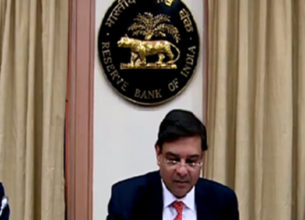RBI’s MPC starts deliberations amid expectations of moderate rate hike
06, Dec 2022

Prelims level : Banking
Mains level : GS-III Indian Economy and issues relating to planning, mobilization of resources, growth, development and employment.
Why in News?
- The Reserve Bank of India‘s (RBI’s) rate-setting panel recently started brainstorming for the next round of monetary policy amid expectations of a moderate interest rate hike of 25-35 basis points as inflation has started showing signs of easing and economic growth tapering.
About the News:
- The RBI has hiked key benchmark lending rate by 50 basis points (bps) thrice since June over and above an off-cycle 40 bps increase in repo in May.
- The current policy repo rate is 5.9%.
- Several other experts too expect the rate hike to be in the range of 25-35 basis points on December 7.
- On September 30, the RBI had hiked the key policy rate (repo) by 50 basis points with an aim to check inflation.
- It was the third successive hike of 50 bps. Before the September hike, the central bank had raised the repo rate by 50 bps each in June and August, and 40 bps in May.
What is Monetary Policy Committee?
- Strong recommendations to set monetary policy committee in India had come from Urjit Patel panel report.
- Monetary Policy Committee is an executive body of 6 members. Of these, three members are from RBI while three other members are nominated by the Central Government.
- Each member has one vote. In case of a tie, the RBI governor has casting vote to break the tie. MPC is required to meet for two days before deciding on rates. Further, it is needed to meet at least four times a year and make public its decisions following each meeting.
- The core mandate of MPC is to fix the benchmark policy interest rate {Repo Rate} to contain inflation within the target level.
- In that context, RBI is mandated to furnish necessary information to the MPC to facilitate its decision. Government also, if wishes to convey its views, can do so in writing to MPC.
Different Terminologies in Banking Sector:
- Loan moratorium period refers to a particular period of a loan tenure during which the borrower does not have repay anything. It can be described as a waiting period before the borrower will have to start paying the equated monthly instalments (EMIs) for his or her loan. It doesn’t mean that he is completely waived off his loans.
- REPO rate (now 5.9%) denotes Re Purchase Option – the rate by which RBI gives loans to other banks. In other words, it is the rate at which banks buy back the securities they keep with the RBI at a later period. Bank gives loan to the public at a higher rate, often 1% higher than REPO rate, at a rate known as Bank Rate.
- RBI at times borrows from banks at a rate lower than REPO rate, and that rate is known as Reverse REPO rate.
- CRR or Cash Reserve Ratio corresponds to the percentage of cash each bank have to keep as cash reserve with RBI (in their current accounts) corresponding to the deposits they have. For example, say if State Bank of India (SBI) got a total deposit of Rs. 1 crore with them, they need to keep 4.5 % of that as cash reserve with RBI (around 4.5 lakh rupees).
The banks and other financial institutions in India have to keep a fraction of their total net time and demand liabilities in the form of liquid assets such as G-secs, precious metals, approved securities etc. The Ratio of these liquid assets to the total demand and time liabilities is called Statutory Liquidity Ratio (18%).









